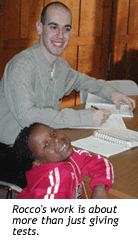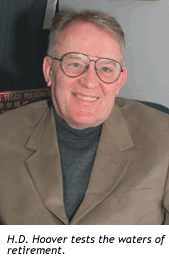|
PSYCHOLOGICAL
& QUANTITATIVE FOUNDATION
Learning
Through Helping Others
 School
Psychology Associate Professor Kit Gerken
spends Wednesday afternoons painting Popsicle sticks, reading
picture books and playing Candy Land. She and three graduate
students are working on a project to test and tutor kindergartners
from Iowa City’s lowest income families at the Broadway
Neighborhood Center. But they get some play time, too. School
Psychology Associate Professor Kit Gerken
spends Wednesday afternoons painting Popsicle sticks, reading
picture books and playing Candy Land. She and three graduate
students are working on a project to test and tutor kindergartners
from Iowa City’s lowest income families at the Broadway
Neighborhood Center. But they get some play time, too.
"The kids are delightful and a lot of fun,” said
Gerken, “and they are very spirited. It’s a challenge."
About a dozen kids regularly attend the after-school program.
In addition to spending time with them as a large group, Gerken
and her crew work individually with the children to test their
academic strengths in areas such as spelling and basic math.
After they identify areas that the children are struggling
with, Gerken and her graduate students tutor them to help
them keep up with school.
“We would like to make sure that the children have a
positive learning experience at school and maybe we can give
them a boost after school to reinforce what they’ve
been learning,” Gerken said.
Sue Freeman, director of the Broadway Neighborhood Center,
said Gerken’s project is a great help for the children
and the center staff.
“It helps us better construct an intervention process
so that we can meet the needs of each individual youth in
the program,” she said.
 Angelo
LaRocco is one of the Ph.D. students involved this year.
He said his work at the center is about more than giving
tests. Angelo
LaRocco is one of the Ph.D. students involved this year.
He said his work at the center is about more than giving
tests.
“This also satisfies a personal desire to do something
that makes a difference in the lives of kids in my own community,”
he said.
Gerken said that’s the point.
“I believe that one of the best ways to learn is through
helping others,” she said. “You learn from the
experience and at the same time are affecting a positive change.”
This is the pilot year for the program, but Gerken said she
hopes it will continue. –by Heather McElvain
Building
Blocks for Employment
The
maxim, “If at first you don’t succeed,”
resonates with School Psychology Associate Professor Kit
Gerken. On a warm evening last spring, she welcomed
local residents to the inaugural Building Blocks for Employment,
a job application-training fair that had been postponed by
a late-winter snowstorm.
Undeterred, Gerken and two dozen volunteers rescheduled and
set up shop five weeks later in the lobby of a local mall
where they offered tips on how to write cover letters, design
resumes, find and apply for jobs, and shine in interviews.
" The fair focuses on people who need jobs but may not
know how to go about finding, getting, and keeping them,”
Gerken says. “We try to encourage people to come by
providing free transportation from the neighborhood centers,
Spanish and Arabic translators, and a supervised area for
children to play while their parents visit the different job-skills
stations."
Six of Gerken’s graduate students also participated
in the event, which was sponsored by government and nonprofit
human service organizations.
Tracy Sims says she learned about the fair from her son’s
teacher at Hills Elementary School. Sims, who is raising three
children while earning her G.E.D. at Kirkwood Community College,
is looking for a full- or part-time evening clerical position.
"I came here to pick up better skills," she said,
"and already I’ve learned how to write a cover
letter. I’ve heard of them, but didn’t know how
to put one together, so this has been great." by Jean
Florman
This
Is Not A Test: H.D. Hoover’s Retiring
 When
Al Hieronymus, emeritus professor in educational
measurement, hired Hiram “H.D.” Hoover
as a graduate assistant in the Iowa Testing Programs (ITP)
in 1964, he knew he was in for an experience. When
Al Hieronymus, emeritus professor in educational
measurement, hired Hiram “H.D.” Hoover
as a graduate assistant in the Iowa Testing Programs (ITP)
in 1964, he knew he was in for an experience.
Born and reared in rural Missouri, Hoover clearly relished
playing the backcountry youth. People who met him, including
the publisher of the Iowa Tests of Basic Skills (ITBS), weren’t
quite sure what to make of Hoover and weren’t entirely
sure that someone with such a distinctive Ozarks twang could
really work for such a nationally prestigious program.
But Hieronymus, a former farm boy himself, quickly saw through
the veneer when Hoover – who was teaching junior high
school mathematics in Bloomington, Ill. while taking graduate
courses at Hieronymus’ alma mater, Illinois State University
– stopped by to talk about the UI College of Education’s
Ph.D. program in educational measurement.
“H.D. showed up one day while I was minding the store
and said he was interested in testing,” recalled Hieronymus.
“We got acquainted and after not too long I offered
him an assistantship because I was very much interested in
his background in mathematics. I was impressed with his general
characteristics: his honesty, his integrity and his disarming
manner.”
Emeritus Professor Leonard Feldt, who laughed
when asked for his first impressions of Hoover four decades
ago, agrees that Hoover was a sight to behold.
“He came up to Iowa out of the depths of Missouri and
had all the characteristics of someone who had been born and
raised in rural Missouri,” recalls Feldt, Ph.D., professor
emeritus and former ITP director. “But for all his external
mannerisms, H.D. was born into a family that prized learning
and inquiry. His father was a teacher in a one-room school.”
Before long, it became clear to Hieronymus, Feldt and everyone
else that Hoover was perfectly suited to the field and in
1987 Hoover was named only the third director (after ITP patriarch
E.F. Lindquist and Hieronymus) of the ITBS, a position he
will hold until he retires on July 1.
From 2001-2002 he served as president of the National Council
on Measurement in Education, the professional organization
for people associated with educational testing. And he has
become internationally recognized as a plain spoken and deeply
knowledgeable supporter of academic testing. He’s often
been quoted in national media for stories on standardized
and high-stakes testing by The New York Times, the Washington
Post, the San Francisco Examiner and PBS.
Hoover has made no secret of his unhappiness over the recent
trend to politicize tests, particularly under the controversial
No Child Left Behind Act. And he plans to speak out
even more on the subject after his
retirement.
“I think those are the wrong uses,” Hoover says.
“They’re short-sighted.”
Hieronymus said that such political pressures forced Hoover
to redefine the ITBS director’s role.
“Lindquist and I could concentrate mostly on the building
of tests and the use of technology,” Hieronymus said.
“We tried to develop the purposes and activities and
the qualities of the tests themselves, to further the objectives
that we considered so important. H.D. has spent a great deal
of his time defending those as best he can. He has done very,
very well at representing the university in the national and
even international community of educational measurement.”
Hoover says his job as a designer and promoter of the ITBS
gave him the best of several worlds: business (through his
work on behalf of Riverside Publishing, which prints and markets
the ITBS), academia and K-12 schools that actually use the
tests Hoover has designed.
“When I was actively directing the Basic Skills Program,
I talked with someone in schools every day,” he said.
“I don’t think there’s any other department
in the college or university with as much day-to-day interaction
with school people as the Iowa Testing Programs.”
Hoover has also loved teaching statistics and mentoring students
in educational measurement. Unfortunately, Hoover, says, recruiting
talented young people to the field of educational measurement
continues to be a daunting challenge because there is no natural
feeder system in higher education. Another challenge is finding
people who can write reliable test questions.
“That’s the single biggest problem facing the
testing industry,” Hoover said. “It’s not
technology. It’s not test theory. It’s getting
good test questions. The only thing there’s an infinite
supply of in the field is bad test questions.”
Still, Hoover said he has every confidence the ITBS program
is in good hands. He has already shifted most of his responsibilities
as ITBS director to Stephen Dunbar, a professor
of educational measurement and statistics who co-directs the
ITP with professors David Frisbie and Timothy
Ansley.
“I’m very optimistic about the future of the ITBS,”
Hoover said. “We’ve got great people.”
Having recently overseen the writing of a new edition of the
ITBS, Hoover is now turning his attention to what he’ll
do during his retirement. He said he’ll remain involved
in the program in some capacity as an emeritus professor.
But what he’s most excited about right now is a planned
trip to visit a son in Switzerland, maybe a little more golf
and an exhibit he’s putting together for the UI Museum
of Art tentatively titled “The History of Iowa in the
Art of Maps.”
The exhibit, slated to go on display in November 2004, will
feature world, national and state maps – some several
centuries old -- that depict features of Iowa few people would
recognize by looking at today’s computer-generated atlases.
He said he became interested in maps when his father took
the family on long road trips. To keep Hoover and his sister
from arguing, his father would give Hoover a stack of maps
and have him plan the trip, saying “get us there.”
“I’m a map nut,” Hoover said.
Feldt said he expects that anyone who has ever encountered
Hoover will remember his particular brand of enthusiasm with
a smile.
“They’ll remember him for his many illustrations
that always had a humorous or sports-related angle to them,
but most of all they’ll remember him for his competency
and his expertise in the field,” Feldt said. “He
still has evidences of that rural Missouri upbringing, but
I think many people recognize now it masks a real substantial
person who has trained many students in the field and who
through his own work has gained a great deal of respect.”
–by Stephen Pradarelli
Westefeld
Concludes Meriwether Lewis Death a Suicide
In 1806, when Meriwether
Lewis and colleague William Clark returned from their expedition
across the western United States, they were hailed as national
heroes.
President Thomas Jefferson, who commissioned the expedition,
rewarded Lewis with—among other things—the governorship
of the newly acquired Territory of Upper Louisiana.
It should have been the beginning of a happy ending for Lewis.
But just three years later, deeply in debt and emotionally
exhausted, Lewis died in a roadhouse along the Natchez Trace
after being shot twice, once in the forehead and one in the
chest.
For nearly two centuries speculation has abounded as to whether
Lewis was murdered—perhaps by a band of brigands—or
whether he died at his own hand. While most historians subscribe
to, and have written extensively about, the theory that Lewis
committed suicide (Jefferson said as much in public comments)
until now there has been little assessment within an explicitly
psychological framework of the facts leading up to his death.
This summer, in the year marking the 200th anniversary of
the Lewis and Clark expedition, University of Iowa counseling
psychology professor John S. Westefeld and
graduate student Aaron Less have produced
"Meriwether Lewis: Was it Suicide?", which seeks
to shed further light on the tragedy.
Their conclusion? Lewis very likely committed suicide.
The article has been accepted for publication next year in
"Suicide and Life-Threatening Behavior," the official
journal of the American Association of Suicidology.
Westefeld, Ph.D., a professor in the UI College of Education's
Department of Psychological and Quantitative Foundations,
used a risk factor model for suicide assessment developed
by Heriberto Sanchez. Westefeld and Less found that the preponderance
of evidence—including Lewis' previous attempts to take
his own life—indicates that Lewis was susceptible to
suicide.
Westefeld, who has studied suicide previously, especially
among college students, says in his study—citing other
sources—that Lewis, born in Virginia in 1774, was a
man of contradictions.
"On the one hand, he was good in a crisis, wilderness-wise,
energetic, a leader, self-disciplined, and he worked closely
with his men," Westefeld writes. "On the other hand,
he had a quick temper, was impetuous at times, a poor politician
and a person who in reality did not view the expedition as
a success by the time he died. Near the end of his life, he
also sunk into extreme debt."
The assessment checklist used by Westefeld and developed by
Sanchez addresses five areas relevant to suicidal tendencies:
historical risk factors (such as substance abuse, major medical
problems and past suicidal behaviors); personal risk factors
(personality, cognitive style and coping patterns); psychosocial-environmental
risk factors (life events and environmental difficulties that
negatively impact an individual's well being and ability to
cope); clinical risk factors (behaviors that suggest planning
for suicide, as well as dramatic changes in mood and mental
state) and protective factors (aspects of a person's life
that lower the risk of suicide, such as a social support system
or marriage).
One of the most notable factors that led Westefeld and Less
to their conclusion was Lewis' suicidal tendencies. In 1809,
after assuming the governorship and after a series of financial
problems, Lewis headed to Washington to ask for assistance.
By the time he had reached Fort Pickering (now Memphis, Tenn.),
Lewis had reportedly attempted twice to take his own life
and was described by witnesses at the time as "in very
bad health" and, even, "deranged."
Lewis left Fort Pickering with James Neeley, a Native American
agent, as well as Lewis' servant John Pernier and a second
scout. On Oct. 9, 1809, the party stopped at Grinder's Stand
for lodging. That night there was the sound of firearms, and
Lewis was found dead. (Some supporters of the suicide theory
suggest that the initial gunshot to the head merely grazed
Lewis' skull and that he was forced to pick up another weapon
and shoot himself again, in the chest, delivering what would
be the fatal shot.)
While his psychological assessment of Lewis points strongly
to suicide, Westefeld says he still can't rule out murder
as a possibility. Grinder's Stand was located along the Natchez
Trace, a passageway that some historians say was home to bandits
and outlaws who frequently committed robbery and violence.
And money was reported missing from Lewis' trunk.
"Although it is easy to think of Lewis in tragic terms,
his life and death can be seen in another way," Westefeld
says in the conclusion of this paper. "When Thomas Jefferson
described him as a man of 'courage undaunted,' he was likely
referring to Lewis' bravery throughout the expedition. That
he accomplished what he did while most probably struggling
with undiagnosed and untreated mental illness indicates a
level of courage of which even Jefferson was unaware."
– by Stephen Pradarelli
|